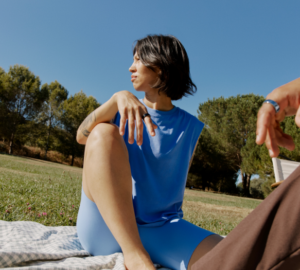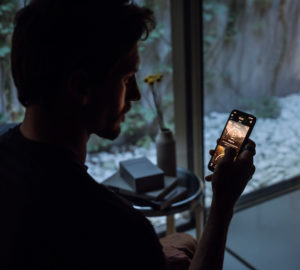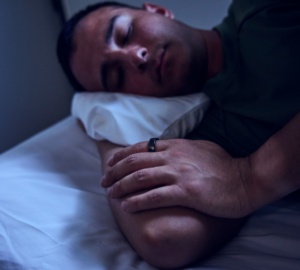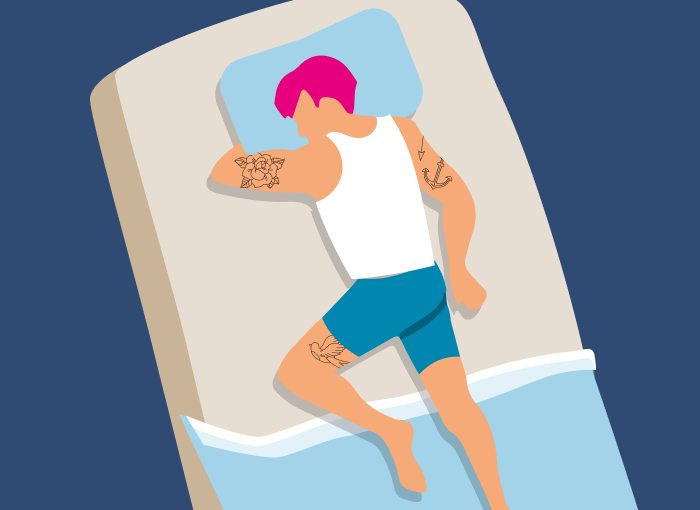- Why do I sleep with one leg bent up? The “one-leg-bent” or “Freefall” position combines features of side and stomach sleeping, with one leg pulled up towards the chest and the other stretched out, which can provide a sense of stability and aid temperature regulation.
- This position may be due to various factors such as body size, pain or medical conditions, feeling unstable in bed, or needing better temperature regulation.
- Oura Ring helps you monitor and optimize sleep by tracking sleep stages, temperature trends, and movements, allowing you to test different sleeping positions and improve sleep quality.
Sleeping position preference varies for everyone. A study by the NCBI found that the majority of the population (54.1%) prefers a side sleeping position, but only 7.3% of people regularly sleep on their front.
One possible stomach-sleeping position some people may take is called the “one-leg-bent” position, also called the “Freefall” position.
| Member Tip: Oura can monitor your sleeping patterns by tracking various factors across and through your body, including temperature trends and minute movements that you make when asleep. |
What is the One-Leg Bent Sleeping Position?
This one-leg-bent pose consists of lying on your front, or with a slight twist to the left or right, with one leg pulled up to your chest, and the other stretched out beneath you — as though you’re taking a running leap. Your arms lie either by your sides, tucked under your body, or under the pillow, which can help support your head.
Below, learn why you may favor this sleep posture, what changes you can make if you’re struggling to get a good night’s sleep, and how using Oura can help you achieve these goals.
READ MORE: 8 Popular Sleeping Positions & What They Mean for Your Health
Why Do I Sleep With One Leg Bent Up?
This hybrid sleeping position combines features found in both side sleepers and stomach sleepers. You can lie completely on your stomach with one leg cocked up towards your head, or with a bit more twist in your body so your shoulder is against the mattress. This usually calls for an arm to be bent, too, giving a similar appearance to the “Yearner” position.
There are several reasons as to why someone may choose to sleep in this way, which can depend both on you as a person, but also your sleep environment.
You’re Too Tall for Your Bed
If you’re a particularly tall person, you may know how it feels to not be able to fit properly on a bed or under the covers. To mitigate the skin-to-air ratio from a limb or two poking out over the sides, perhaps you’ve learned to sleep with your legs bent to keep you well-insulated.
Whilst you may feel as though this works for you, this angle might be putting unnecessary strain on the twisted or bent parts of the body. Even if you are unable to buy a bigger bed, consider purchasing a larger duvet, or additional blankets that help to cover all of you at night.
You Might Have Pain or a Medical Condition
The body is a fickle thing, and sometimes it hurts for the wrong reasons, or even no reason at all. If you suffer from joint or muscular pain, you may have a very specific position to lie in which alleviates these sores.
Alternatively, you may have a condition called Periodic Limb Movement Disorder, which can increase your risk of hypertension over time. PLMD usually only affects the body below the waist, and, in the 4-11% of adults who suffer from it, it is most commonly found to affect the feet or knees. This is similar to the research conducted for office workers, truck drivers, and others who find themselves sitting down a lot during the day. Keeping your knees bent for an extended period of time can have adverse effects on your physical wellbeing.
You May Feel Unstable in Bed
Creating a larger surface area with your body with one leg bent up provides a sense of stability in bed. For those of us that move around a lot in our sleep, have to sleep on a slight incline, or share the bed with a heavier partner, having one leg bent up can act as an anchor to help with weight distribution and stop us from migrating around the bed.
You May Need Better Temperature Regulation
It can be easier to regulate your body temperature when you have a leg bent, as your limbs aren’t pressed against one another, so you have a more even distribution of heat across the body. Moreover, for someone who suffers from eczema, or who sweats a lot, the sensation of skin-on-skin can be incredibly uncomfortable. Spreading out across the bed makes for more comfortable sleeping.
Many factors affect your temperature trends — not only the weather outside. For instance, a sudden increase may mean you are becoming ill, or that you are in the second half of your menstrual cycle.
| Member Tip: Oura technology allows you to keep track of how your temperature trends fluctuate throughout the day, providing valuable insight into your internal well-being. |

Benefits and Drawbacks of Sleeping with One Leg Bent Up
While sleeping with a leg pulled up towards your chest can certainly be comfy, there may be a few issues that come with it. Let’s look over the pros and cons of this pose, so you can decide for yourself how to sleep better.
Benefits
- Reduced snoring: Sleeping with one leg bent often calls for someone to be laying on their side, or on their stomach. This helps alleviate the issues that come with back sleeping, such as sleep apnea, which many snorers suffer from.
- Clearer airways: When rolled more to one side than the other, the half-stomach position is reminiscent of the recovery position, which keeps you in the optimal pose for unobstructed airways. This ensures that you can keep a clear airflow throughout the night for a more restful sleep.
- Familiarity: Sleeping with a leg curled towards your chest is similar to sleeping in a fetal position. Studies have shown that this can lessen the impact of sleep disorders, and is generally considered one of the most comforting and secure sleeping positions.
RELATED: The Impact of the Fetal Position on Overall Sleep Quality
Drawbacks
- Hip and back pain: Half-stomach sleeping can cause displacement of pressure along your pelvic region, which can aggravate lower back pain and cause strain on your muscles.
- Neck pain: Additionally, sleeping on your stomach requires your neck to be turned to the side. If you sleep with one leg up entirely on your front, rather than rolled partially to one side, this can cause muscle strain in your neck as you need to turn your head a greater degree to breathe. This may also exacerbate any existing shoulder pain. Whilst it may be comfortable initially, it is not a sustainable pose.
- Pins and needles: An excessive bend in your leg for a prolonged period of time can restrict the blood flow to your feet. This can cause a tingling or numb sensation in the morning.
- Space: Ultimately, sleeping with one leg drawn up takes up a lot of room. This is detrimental when you’re sharing a bed with a partner, and can decrease their quality of sleep as well as yours.
- Pressure: Sleeping on your front can put pressure on your stomach, which may aggravate heartburn and acid reflux.
RELATED: What Is a “Sleep Divorce” & Is It Right for Your Relationship?
6 Tips to Sleep Comfortably With One Leg Bent
It’s near impossible to change a lifelong sleeping habit overnight. Plus, you have next to no control over your body when you’re sleeping, so it’s hard to consciously change what position you lie in. As a result, you may have to put physical barriers in place to keep you sleeping in a certain way.
Here are six useful tips that can help you manage the ‘one-leg-bent’ pose, and adapt it into a more sustainable sleeping position, without impacting your comfort.
1. Make Use of Pillows
If you suffer from PLMD and find yourself moving about the bed at night, try creating a barrier for yourself with pillows. Wedging something between your knees can help stabilize you in bed, and take the pressure off your pelvis. Moreover, it still maintains a gap between your legs if you find it uncomfortable to have your limbs touching each other when you sleep.
Alternatively, adding a pillow under your hips and knees to gently elevate your legs helps if you have poor circulation, or are prone to swelling at night.
READ MORE: How to Choose the Best Bedding for a Better Night’s Sleep
2. Find a Mattress That Suits Your Sleeping Style
It’s a common trap that people fall into where they think one mattress type fits all. This, unfortunately, is not the case. Depending on the natural curve of your back, your shoulder and chest width, or the size of your pelvis, you’ll find that there’s one type of mattress that suits you best.
Experiment with varying degrees of softness. Do you find it easier to sleep in a bed you can sink into and contours to your curves, like memory foam? Or do you feel better rested after laying on a firmer mattress that supports your back?
If one of your reasons for sleeping with a leg bent upwards is due to a sense of stability, then getting a new mattress may help with your overall weight distribution.
3. Gently Tie Your Legs Together
It may sound intense, but another technique for dealing with PLMD is by gently tying your legs together with a soft material, like a dressing-gown belt or a scarf. This prevents your foot or knee from creeping upwards in the night, and can train you out of a potentially painful position.
Here’s a brief warning from sleep expert Dr. Michael Breus: “Having both legs up during sleep would pull weight off the pelvis, and could potentially help someone with low back pain, but one leg up may do the opposite.”
4. Swap Sides
If you currently sleep further towards your right side with a leg bent up and have difficulty sleeping, try switching to your left side. Even if you don’t change how your leg is positioned, you’ll most likely see some improvements in your quality of sleep because you’re alleviating pressure on your cardiovascular and digestive systems.
5. Improve Your Sleep Hygiene
Sleep hygiene refers to the environment around you in your bedroom. You may find that you are experiencing poor sleep because you’re practicing poor habits. If your room is too bright, too noisy, or the wrong temperature, these can all contribute to not sleeping well. Improve the space around you, and you’ll find that your quality of sleep will improve as well.
READ MORE: Get Back on Track: 5 Ways to Sleep Better Tonight

Track How You Sleep With Oura
If you want to test the effectiveness of each technique, then you need something to help you monitor your progress and changes. Oura’s highly accurate sleep staging algorithm allows you to keep an eye on the quality of the sleep you’re getting, by tracking the duration of your sleep stages.
By wearing an Oura Ring, you can set a baseline which you can then refer back to each time you change how you sleep. Since everyone is different, certain methods may not be as effective. Definitive, qualitative — and accurate — data can help you achieve the best sleep position possible.
RELATED: 8 Popular Sleeping Positions: Find Out What They Mean For Your Health




